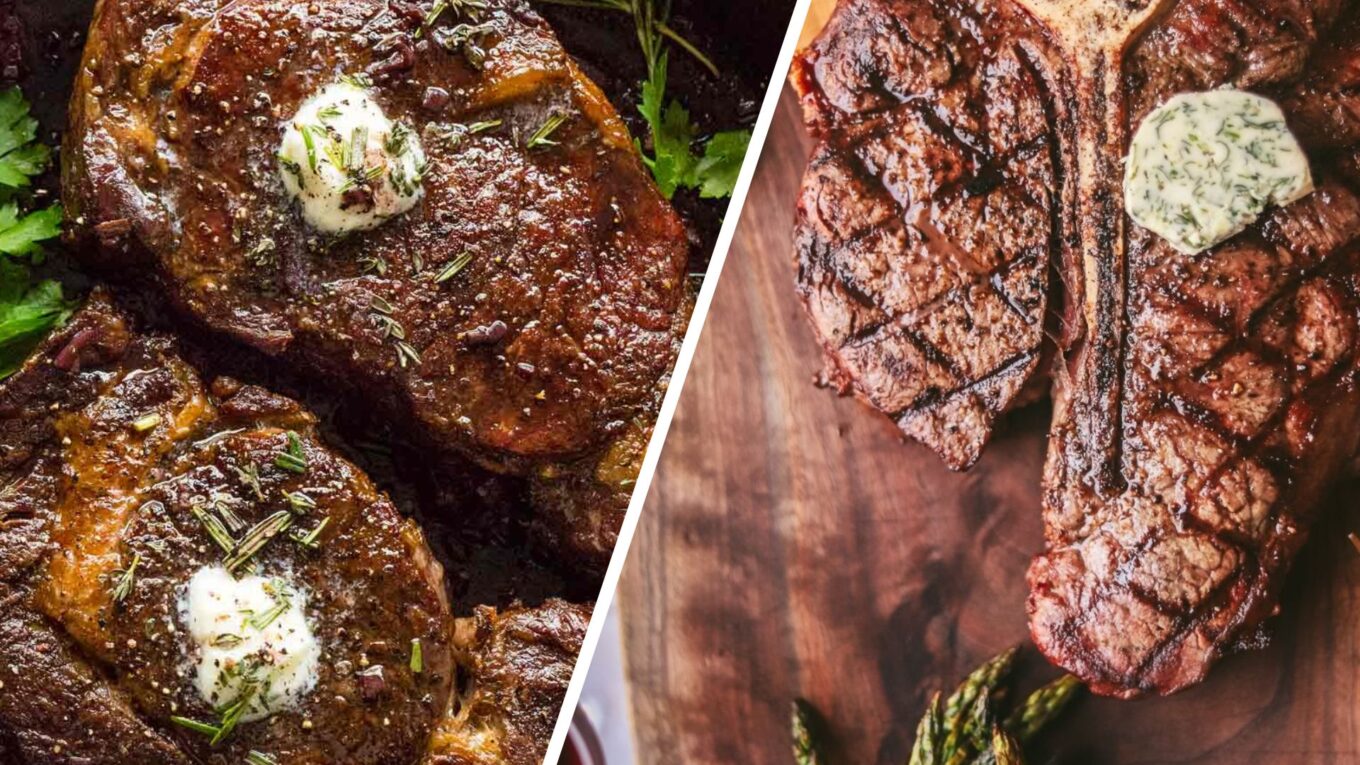Grilling the perfect steak is an art that many aspire to master.
Whether you’re a seasoned grill master or a novice, choosing the right cut of meat is crucial for a delicious, satisfying meal.
Two of the most popular and flavorful steaks for grilling are the T-bone and ribeye. In this article, we’ll explore the unique characteristics of each cut, helping you understand their differences and similarities.
By the end, you’ll have a clear idea of which steak best suits your next grilling adventure, ensuring you can create a mouthwatering, impressive meal for your family and friends.
So, fire up the grill and dive into the world of T-bone and ribeye steaks!
What is T-Bone Steak?

The T-Bone steak is distinguished by its T-shaped bone, which divides two different types of meat on either side. On one side of the bone is the tenderloin, and on the other is the strip steak.
This unique structure gives the T-Bone its signature look and lets steak lovers enjoy two cuts of meat in one serving.
1. Flavor and Texture
The T-Bone steak offers a unique dual-flavor experience, combining the mild, buttery flavor of the tenderloin with the rich, beefy taste of the strip steak.
While the tenderloin is known for its soft, melt-in-your-mouth texture, the strip steak offers a firmer, chewier texture, appealing to those who enjoy a more pronounced bite.
This contrast in flavors and textures makes the T-Bone popular among steak enthusiasts who appreciate variety in their meals.
2. Ideal Cooking Methods
The diverse textures of T-Bone steak make it ideal for grilling or pan-searing, techniques that enhance its natural flavors.
Grilling quickly sears the outside while preserving the tenderloin’s tenderness and enhancing the strip steak’s robust flavor.
The grill’s high heat creates a delightful char on the exterior, sealing in the juices and adding a smoky note to the meat. Pan-searing allows precise control over doneness, ensuring each texture is showcased perfectly.
The direct contact with the hot pan creates a caramelized crust on the steak’s surface, intensifying the tenderloin and strip steak flavors.
What is Ribeye Steak?

The Ribeye steak is cut from the rib section of the cow, and it is known for its rich marbling, which enhances both flavor and texture.
This steak primarily consists of the longissimus dorsi muscle, alongside smaller amounts of the spinal and complexus muscles, contributing to its luxurious taste.
1. Flavor and Texture
Ribeye is celebrated for its exceptionally tender texture and deep, pervasive beefy flavor, magnified by its significant fat marbling.
The extensive marbling not only tenderizes the steak during cooking but also infuses every bite with a rich, satisfying flavor that is consistently juicy throughout.
As the steak cooks, the fat melts and bastes the meat, ensuring a succulent and flavorful experience from the first bite to the last.
2. Ideal Cooking Methods
Ribeye steaks are versatile and can be prepared using various high-heat methods that render their fat and highlight their flavors.
Grilling makes the fat render beautifully, creating a crispy exterior over a juicy interior.
The flames kiss the steak’s surface, imparting a delightful smoky flavor that complements the Ribeye’s natural richness. Pan-searing in a hot skillet caramelizes the surface for enhanced flavor, creating a tantalizing crust that gives way to a tender, juicy center.
Broiling in a high-heat environment ensures a deliciously charred finish, allowing the steak’s flavors to intensify and develop a delightful complexity.
Comparison of T-Bone and Ribeye
| Feature | T-Bone Steak | Ribeye Steak |
|---|---|---|
| Cut Location | Cut from the short loin section of the cow, featuring the T-shaped bone that separates the tenderloin and strip steak. | Sourced from the cow’s rib section, it often includes a rib bone in bone-in varieties. |
| Taste and Texture | The tenderloin (mild and tender) and strip steak (robust and chewier) offer a dual flavor profile. | Known for its uniform richness and beefy flavor due to extensive marbling, resulting in a consistently tender texture. |
| Flavor Profile | Combines the mild, buttery flavor of the tenderloin with the more intense, beefy taste of the strip steak. | It features a rich, deeply beefy flavor that is intense and decadent due to its high-fat content. |
| Fat Content and Marbling | Moderate marbling contributes to a balanced flavor and texture, particularly in the strip steak portion. | Highly marbled throughout, which enhances its juiciness and flavor, making it extremely succulent. |
| Cooking Preferences | The distinct textures of the tenderloin and strip steak allow for diverse cooking experiences; they can be grilled or pan-seared to different doneness levels within the same cut. | Its uniform texture is ideal for consistent cooking methods like grilling, pan-searing, or broiling, maintaining even juiciness and tenderness. |
| Price Difference | Generally less expensive than Ribeye, price varies based on the proportion of tenderloin to strip steak. | It is typically more expensive than T-Bone due to the high demand for its marbling and tenderness, especially for prime grades. |
What to Look for in a Great Cut of Steak
Choosing the perfect steak is essential for a delicious grilling experience.
When selecting your T-Bone or Ribeye, consider these key factors to ensure a top-quality cut.
1. Thickness and Marbling
The Pillars of a Great Steak A thicker cut with good marbling is crucial for ensuring juiciness and flavor.
Marbling refers to the white flecks of fat within the meat, which melts during cooking to naturally baste the steak, keeping it moist and adding rich flavors.
Steaks should ideally be at least 1.5 inches thick for better heat distribution and a good outer sear without overcooking the inside.
This thickness lets you achieve a beautifully browned exterior while maintaining a tender, juicy center.
2. The Importance of Color and Freshness
The steak’s color is an indicator of freshness and quality. Depending on the cut, the fresh steak should have a bright red or purplish hue.
Avoid steaks that look dull or grayish, as this may suggest the meat is not at its peak freshness. A vibrant color signifies well-handled and properly processed meat, ensuring flavor and texture.
3. Seeking Wisdom
Consult Your Butcher Consulting with butchers can help you make informed choices when selecting your steak.
Ask your butcher about the best cuts for specific cooking methods and what they recommend for certain occasions or recipes.
Butchers can offer valuable insights into the source of the meat, its aging process, and how these factors might influence taste and cooking performance. They can guide you toward the perfect cut based on your preferences and needs.
6 Tips Before You Start Grilling Steak
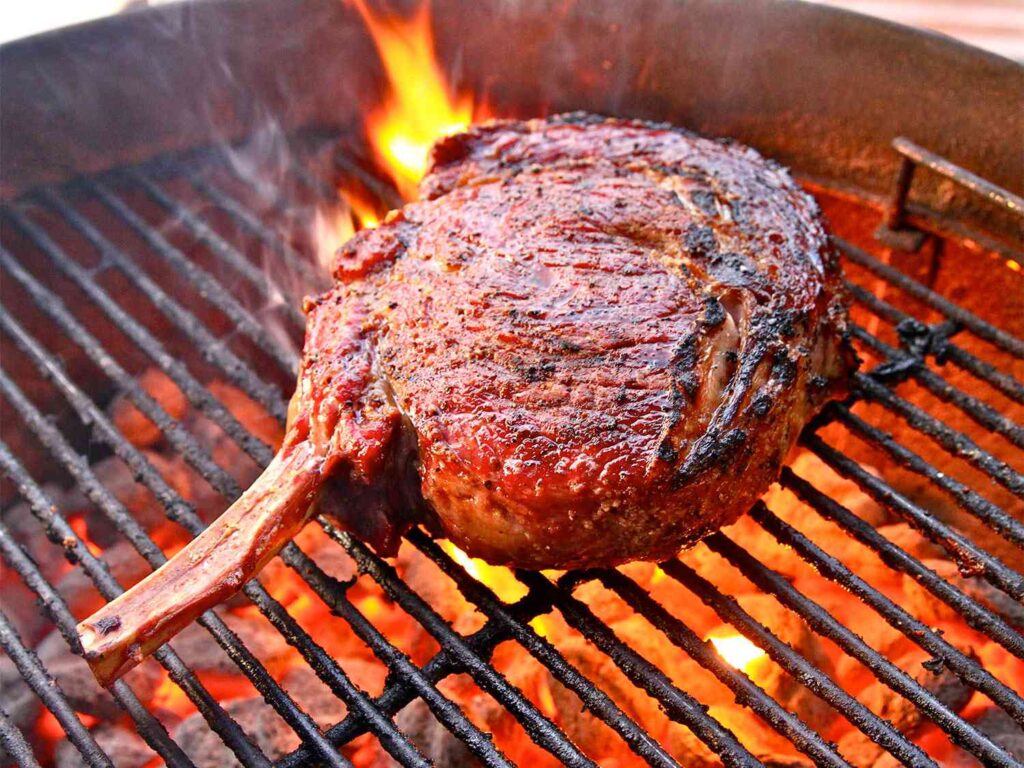
Before firing up the grill, remember these essential tips to ensure your T-bone or Ribeye steak turns out perfectly every time.
1. Start at Room Temperature
Take the steak from the fridge about 30 minutes to an hour before cooking.
This allows the meat to cook more evenly and reduces the risk of overcooking the outside while the inside is still cold. Room-temperature steaks also tend to develop a better sear and crust when grilled.
2. Season Strategically
Seasoning the steak with salt at least 45 minutes before grilling helps to break down proteins and draw moisture to the surface, forming a perfect crust when seared.
Other seasonings, like pepper or garlic powder, can be added just before cooking to prevent burning. Remember, simple seasoning is often best when working with high-quality cuts like T-bone and Ribeye.
3. Create Heat Zones on Your Grill
Set up direct and indirect heat zones on your grill for optimal control.
Arrange coals on one side of the grill or turn on only half the burners, creating one hot zone for searing and a cooler zone for slower cooking.
This technique allows you to manage the cooking temperature better and reduces the chances of burning the steak.
4. Use a Meat Thermometer for Precision
A meat thermometer ensures your steak reaches the perfect doneness every time.
Insert the thermometer into the thickest part of the steak for the most accurate reading. Aim for these internal temperatures: 125°F for rare, 135°F for medium-rare, 145°F for medium, and 155°F for well-done.
5. Let It Rest
After grilling, let the steak rest for 5-10 minutes before cutting and serving.
This rest period allows the juices to redistribute throughout the steak, ensuring a more flavorful and juicy bite. Cover the steak loosely with foil during this time to keep it warm.
6. Manage Flare-ups Like a Pro
To avoid flare-ups caused by fat drippings, trim excess fat from the steak before grilling. Use a drip pan to catch fat, and keep a water spray bottle handy for dousing any unexpected flames.
When grilling fattier cuts, keep the lid open to allow air circulation and prevent the build-up of flammable gases.
Iconic Dishes: T-Bone Steak
1. T-Bone Steak Florentine (Bistecca alla Fiorentina)
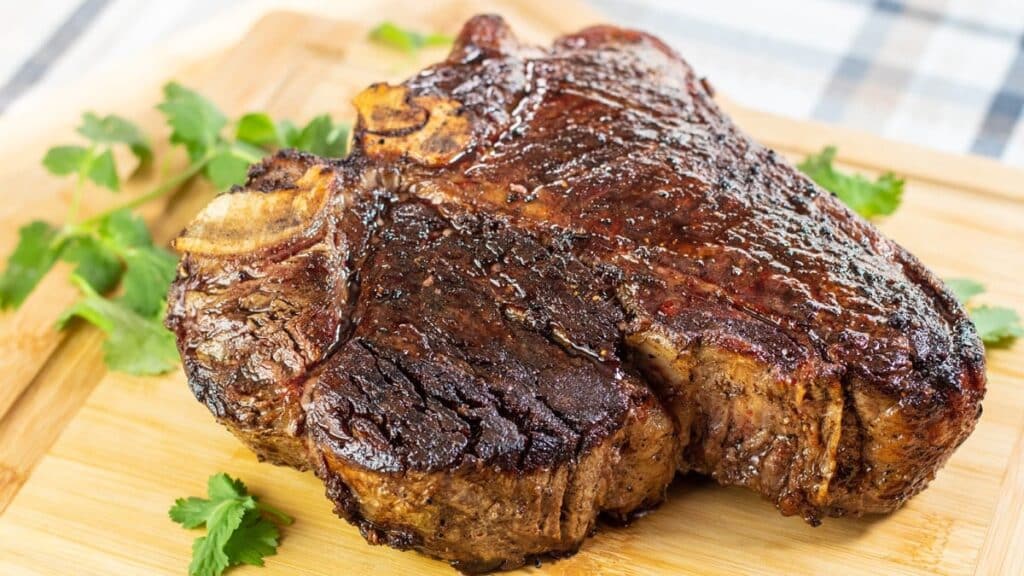
This classic Italian dish is known for its simple seasoning and high-heat grilling, which showcases the T-bone’s natural flavors.
Originating in Florence, this preparation typically uses a thick T-bone steak seasoned with salt, pepper, and olive oil.
The steak is grilled over high heat, allowing the exterior to develop a flavorful crust while the interior remains tender and juicy. To taste Tuscan cuisine, serve this dish with roasted potatoes and a fresh salad.
2. Garlic Butter T-Bone Steak
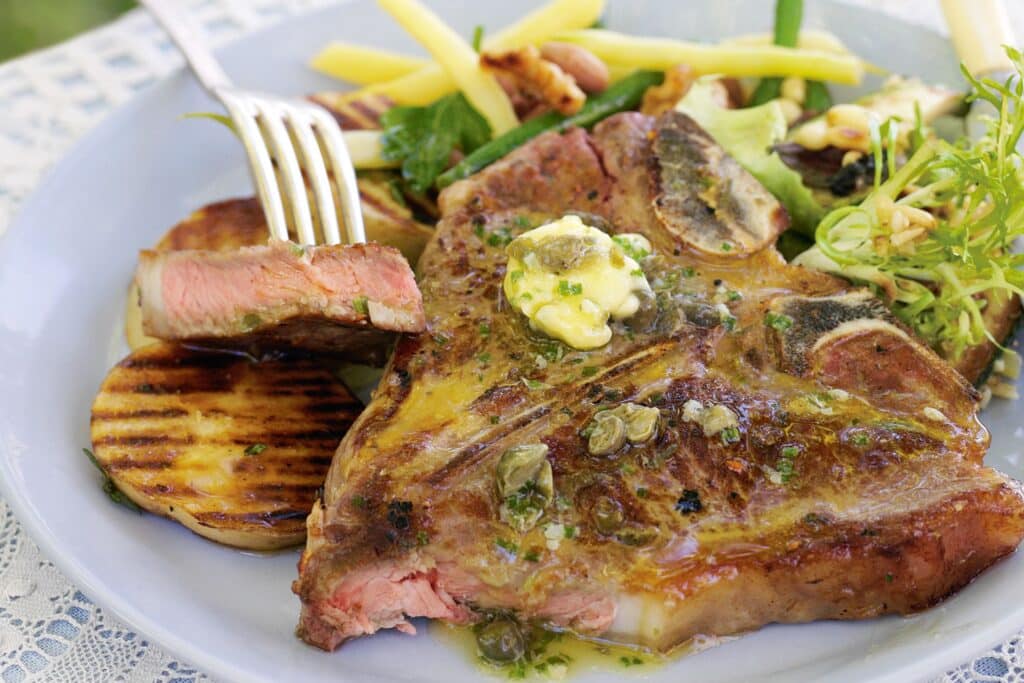
Garlic butter enhances the flavor of the steak, making it a favorite in many Western cuisines.
To prepare this dish, mix softened butter with minced garlic, salt, and herbs like parsley or thyme. Grill the T-bone steak to your desired doneness, then top it with a generous dollop of the garlic butter mixture.
As the butter melts, it infuses the steak with a rich, savory flavor that complements the meat’s natural taste.
3. T-Bone Steak with Chimichurri Sauce
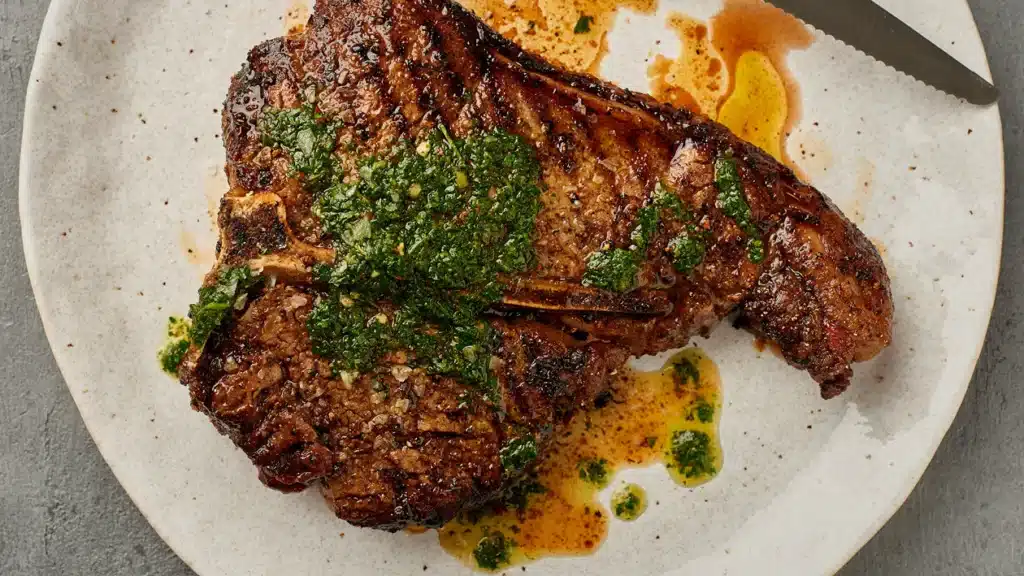
This South American twist pairs the robust flavors of the steak with a fresh, herby chimichurri sauce.
Chimichurri, which originates from Argentina and Uruguay, is made with finely chopped parsley, garlic, olive oil, red wine vinegar, and red pepper flakes. Grill the T-bone steak to your liking, then serve it with a generous spoonful of chimichurri sauce on top.
The sauce’s bright, tangy flavors cut through the meat’s richness, creating a delightful balance of tastes.
Iconic Dishes: Ribeye Steak
1. Ribeye Steak with Blue Cheese Butter
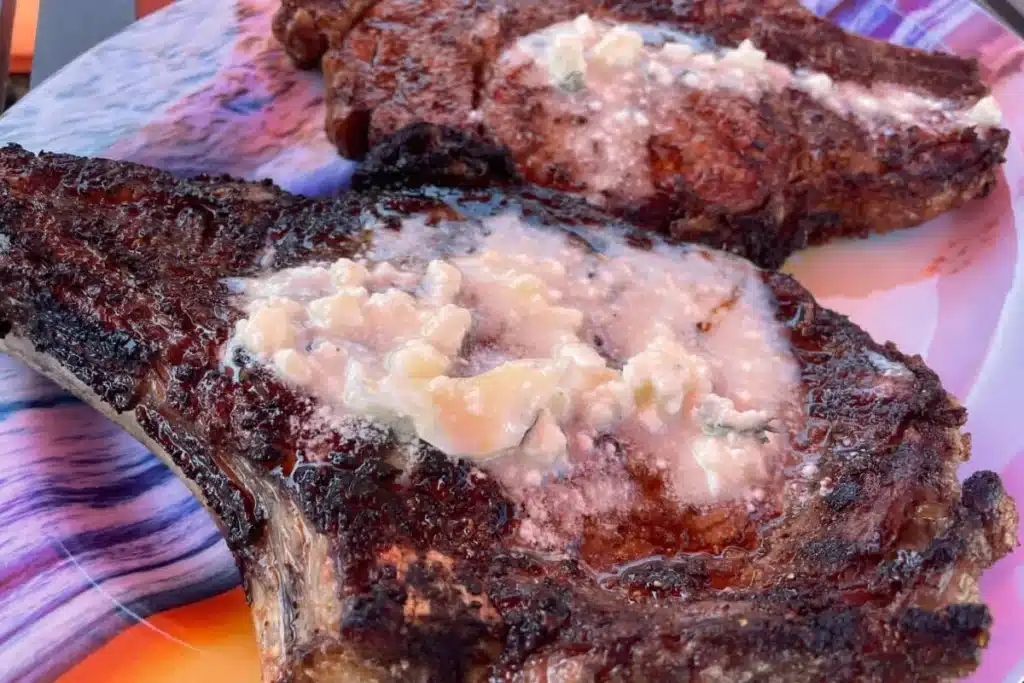
This dish is a staple that combines the rich, fatty profile of Ribeye with the sharp contrast of blue cheese butter.
Mix crumbled blue cheese with softened butter, garlic, and herbs to make the butter. Grill the Ribeye steak to your preferred doneness, then top it with a slice of blue cheese butter.
As the butter melts, it creates a decadent sauce that complements the steak’s beefy flavor and tender texture.
2. Cowboy Ribeye (Bone-in Ribeye)
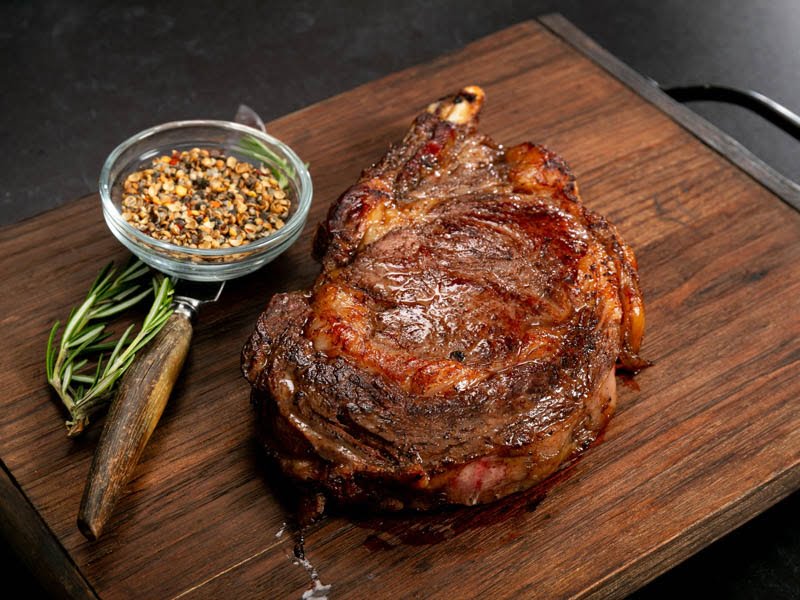
The bone-in version of Ribeye is typically grilled over open flames, providing a highly prized smoky flavor.
Also known as a tomahawk steak, this cut features a long bone that extends from the steak, giving it a striking appearance.
Season the steak with salt and pepper, then grill it over high heat, allowing the bone to impart additional flavor to the meat. Serve this impressive dish with roasted vegetables and a bold red wine.
3. Ribeye au Poivre (Peppered Ribeye)
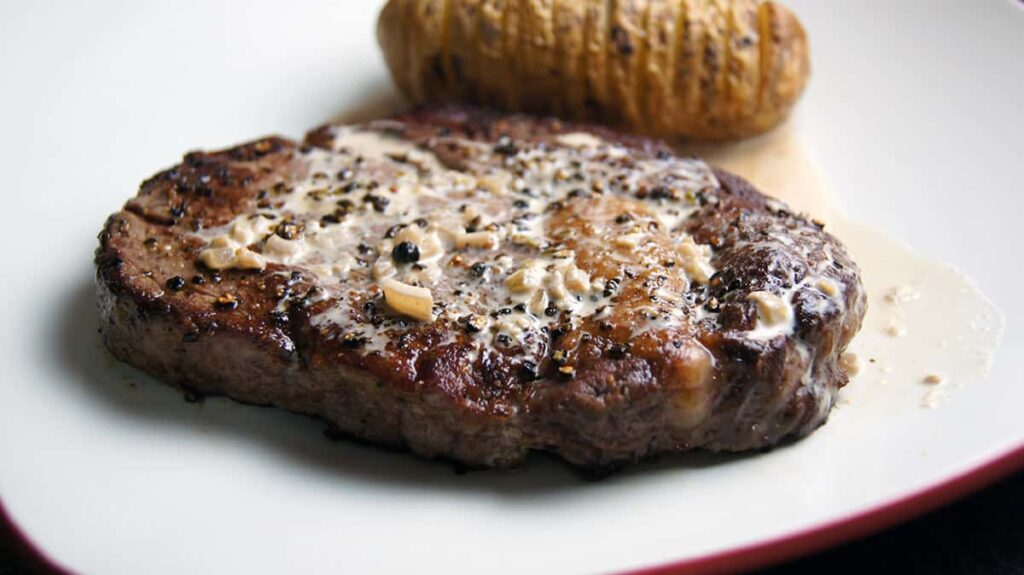
This French-inspired dish features a Ribeye steak crusted with cracked peppercorns before being pan-seared.
To prepare, press coarsely ground black peppercorns onto both sides of the steak.
Heat a skillet with butter and oil, then sear the steak on both sides until it reaches your desired doneness. The peppercorns create a spicy crust that complements the steak’s rich flavor.
Serve this dish with a creamy peppercorn sauce made with cognac, beef stock, and heavy cream for an extra touch of luxury.
Wrapping It Up
When it comes to choosing between T-Bone and Ribeye steaks for your next grilling adventure, it ultimately depends on your personal taste preferences and cooking style.
Both cuts offer unique flavor profiles and textures that can elevate your meal to new heights.
By understanding the anatomy, marbling, and ideal cooking methods for each steak, you can make an informed decision and create an impressive dining experience for your guests.
Remember to select high-quality, fresh cuts and follow our expert grilling tips for the best results.
Whether you opt for the dual-flavored T-Bone or the rich, marbled Ribeye, you’re sure to enjoy a delicious, satisfying meal that showcases the true potential of these iconic steaks.
So fire up the grill and savor the mouthwatering flavors of your perfectly cooked T-Bone or Ribeye steak!

